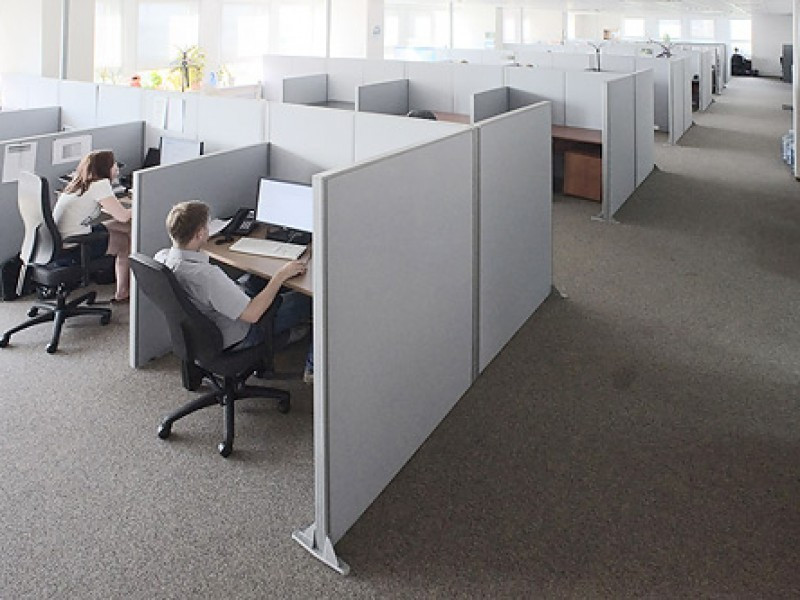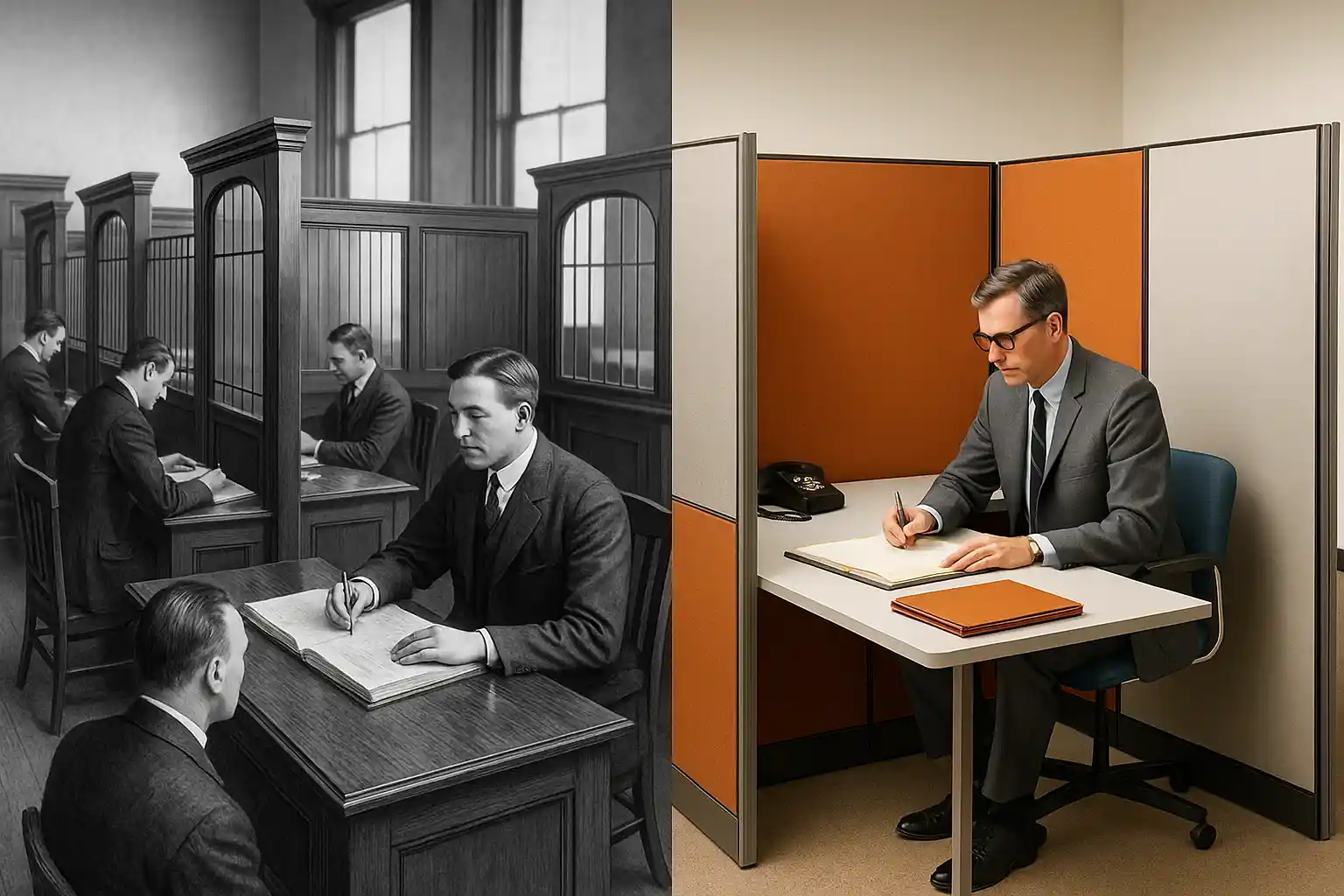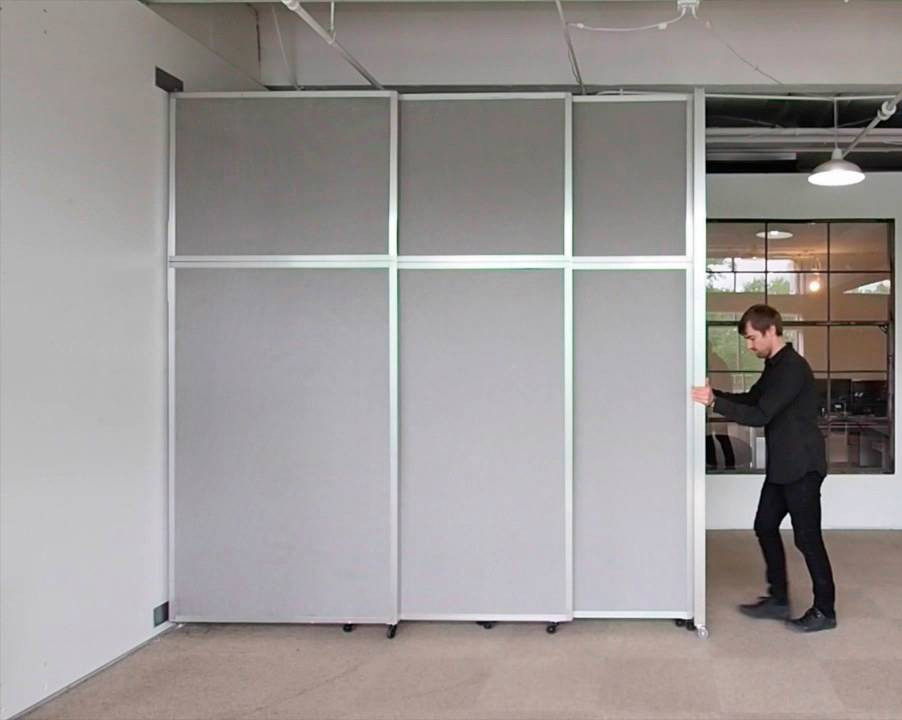Office dividers have become an indispensable element in creating a functional and comfortable workspace. Modern office structuring using partitions not only serves the practical functions of space division but also significantly increases employee productivity. Have you ever thought about how important the work environment is for your team's efficiency? According to research, a well-organized office space using dividing systems for zoning can increase staff efficiency by up to 15%.
"In the era of hybrid work models, properly selected office partitions have become not just a design element, but a strategic tool for creating adaptive workspaces. They help employees feel comfortable and focused both when working together and when performing individual tasks," — notes Alexey Morozov, a leading specialist in office space organization.
Types of Office Partitions: Functions and Materials
 The choice of suitable structures for office division depends on the specifics of the business, interior style, and budget. Modern office dividing systems differ in purpose, design, and materials used. Have you already decided which type of partitions would be perfect for your office?
The choice of suitable structures for office division depends on the specifics of the business, interior style, and budget. Modern office dividing systems differ in purpose, design, and materials used. Have you already decided which type of partitions would be perfect for your office?
By purpose and installation method:
- Stationary partitions, which serve as a full-fledged alternative to traditional walls and provide reliable sound insulation;
- Mobile partitions, allowing efficient division of space into functional zones while maintaining its integrity and the possibility of quick transformation;
- Sliding partitions, which save space and allow for rapid changes in office configuration;
- Office screens — light and compact dividers for quick visual zoning.
By manufacturing materials:
- Glass partitions — a modern solution that provides natural lighting and visual perception of space integrity (available in transparent, frosted, and tinted versions);
- Aluminum partitions — a practical and durable option with extensive design possibilities;
- PVC profile-based partitions — an economical solution for office zoning;
- Acoustic partitions — a specialized solution for reducing noise in open-space offices;
- Fire-resistant office partitions — ensure safety and comply with strict fire safety standards.
The choice between different types of dividing systems for organizing office space depends on specific tasks: for isolated executive offices, stationary sound-insulating partitions work well; for reception areas — glass partitions with frosted glass; and for flexible zoning of the workspace — mobile office screens or modular partition systems.
Research shows that well-planned office zoning using partitions directly affects staff productivity and the quality of team communication. Scientific data confirms that to ensure conversation confidentiality in open-type offices, it's necessary to consider not only the height of partitions but also their placement relative to workstations.
History of Office Partitions: From Origins to Modern Times
 The history of office partitions spans more than a century. The first office dividers appeared in the 1920s and were heavy wooden screens used in banks and law firms to separate clerks from clients. A real revolution in office space organization was made by designer Robert Propst, who created the "Action Office" system with hinged partitions in the 1960s to provide workplace flexibility.
The history of office partitions spans more than a century. The first office dividers appeared in the 1920s and were heavy wooden screens used in banks and law firms to separate clerks from clients. A real revolution in office space organization was made by designer Robert Propst, who created the "Action Office" system with hinged partitions in the 1960s to provide workplace flexibility.
Unfortunately, his vision was distorted, and by the 1980s, cramped cubicles emerged, which Propst himself later called "hellholes." Astonishing, isn't it? A noble idea transformed into what became a symbol of office congestion and facelessness. This shows how important it is to approach the design and dismantling of office partitions competently, avoiding mistakes when installing zoning systems that could lead to employee discomfort.
Today, office partitions are experiencing a new stage of evolution, associated with changes in work culture and technology. The production of office partitions focuses on creating adaptive, environmentally friendly, and aesthetic solutions that can transform along with business needs.
Impact of Office Barriers on Employee Productivity
The functional division of work zones using partitions has a direct impact on employee work efficiency. According to a study by Lee and Haan (2024), the placement of partitions in open-space offices plays a key role in providing acoustic comfort and conversation privacy. Surprisingly, did you know that simply changing the placement of partitions can radically alter the work atmosphere? The authors identify four main layout schemes: face-to-face, parallel type, crosswise, and orthogonal. Results show that parallel and crosswise partition arrangements work best for ensuring conversation confidentiality, and it's also important that employees don't sit facing each other. Modern office sound-absorbing solutions can reduce noise levels by up to 40 dB, which is critically important in open office spaces.
Let's consider how different types of partitions affect the work environment and staff productivity, as well as their durability and economic efficiency:
| Partition Type | Impact on Productivity | Features | Durability | Optimal Application |
|---|---|---|---|---|
| Acoustic partitions | 25% increase in concentration | Noise reduction up to 40 dB | 8-10 years with proper care | Call centers, open space offices |
| Glass partitions with frosted glass | 15% mood improvement | Natural lighting with privacy | 15-20 years | Reception areas, meeting rooms |
| Mobile partitions | Task adaptability (+10% efficiency) | Quick space transformation | 5-7 years with active use | Hybrid work models, coworking spaces |
| Modular partition systems | Work process optimization (+18%) | Scalability and flexibility | 10-15 years with upgrade options | Growing companies, multifunctional offices |
| Biophilic partitions | 12% stress reduction | Integration of plants and natural elements | Require regular maintenance | High-stress offices |
| Sliding partitions | Space flexibility (+15% efficiency) | Space saving | 12-15 years with regular maintenance | Multifunctional spaces, conference halls |
| Fire-resistant partitions | Increased safety | Compliance with fire safety regulations | 15-20 years with mandatory certification | Server rooms, archives, offices in high-rise buildings |
This statistics demonstrates that properly selected office dividers don't just organize space but also create an optimal work atmosphere that affects all aspects of company operations. When choosing, one should consider the durability of materials and the potential need for future dismantling of office partitions.
Advantages of Various Types of Office Dividers
 Modular partition systems for offices offer limitless possibilities for interior design and space organization. According to research by Zhu and Niu (2022), the popularity of environmentally friendly materials for office furniture and partitions is growing, corresponding to the trend of sustainable development and circular economy. Isn't it inspiring to think that your office can not only increase productivity but also contribute to environmental preservation? Mobile and sliding partitions can be made in various styles, including minimalist office design, and color schemes, while differing in construction: they can be fixed to the floor, have wheels for easy movement, or be installed on a desktop to create individual work zones.
Modular partition systems for offices offer limitless possibilities for interior design and space organization. According to research by Zhu and Niu (2022), the popularity of environmentally friendly materials for office furniture and partitions is growing, corresponding to the trend of sustainable development and circular economy. Isn't it inspiring to think that your office can not only increase productivity but also contribute to environmental preservation? Mobile and sliding partitions can be made in various styles, including minimalist office design, and color schemes, while differing in construction: they can be fixed to the floor, have wheels for easy movement, or be installed on a desktop to create individual work zones.
Organizing space in an office using different types of partitions has several advantages:
- Flexibility and adaptability to changing company needs;
- Savings on renovation work during office reorganization;
- Ability to quickly repurpose space for different tasks;
- Improved office acoustics without capital changes;
- Creation of private zones in open space;
- Economical office partitions allow for optimization of renovation budget;
- Zoning without walls allows for preserving and easily changing the room layout.
"In 2025, the trend for glass partitions in offices has reached peak popularity. Transparent or frosted glass partitions create a sense of openness while providing necessary privacy. They are especially in demand in technology and creative offices, where it's important to maintain a spirit of collaboration," — comments Maria Sokolova, an architect and office design specialist.
Modern environmentally friendly materials for office partitions can reduce a company's carbon footprint by 20% compared to traditional solutions, which corresponds to the current ESG goals of many organizations. The rational use of green materials is becoming a necessary step for the development of environmentally clean production and circular economy in the field of office furniture and partitions.
Success Story: Partitions as the Key to an Innovative Office
A bright example of the effective use of office partitions for zoning is the experience of Campari America. In 2019, the Campari America headquarters in New York, designed by Gensler, used combined office partitions to create a dynamic space reflecting the brand's values. Imagine an office where every element of the space tells the company's story! Mobile glass and acoustic partitions divided the open space office into zones for collaborative work and quiet corners for concentration.
Employees choose workstations on a first-come, first-served basis, and store personal items in lockers, providing flexibility in space usage. Five themed bar areas, including a secret speakeasy, promote informal communication and strengthen corporate culture. The result is evident — surveys showed a 20% increase in employee engagement after implementing the new office zoning system.
"Modern office partitions are not just a functional element but also a reflection of the company's corporate culture. With the right approach to zoning the workspace, partitions become a tool for forming the employer's brand and increasing the attractiveness of the office for talented specialists," — explains Dmitry Karpov, organizational development consultant.
How to Choose Office Partitions: Key Factors
 When choosing partitions for an office, several important criteria should be considered:
When choosing partitions for an office, several important criteria should be considered:
- The functional purpose of the room and the specifics of staff work;
- The required level of sound insulation (especially for meeting rooms and executive offices);
- Design features and the overall style of the office space;
- Budget and company development prospects;
- Environmental friendliness of materials and compliance with safety standards;
- Possibility of installing additional equipment (monitors, shelves, etc.).
Modern office partitions offer a wide range of solutions for any zoning tasks, from creating fully isolated offices to light screens for visual separation of desks in an open space office. What zoning tasks does your company face today?
Conclusion
The choice of suitable structures for office division plays a key role in creating a productive and comfortable work environment. From stationary to mobile, from glass to aluminum — each type of office divider offers unique advantages, meeting various business needs.
With the growing popularity of hybrid work models, sliding and modular partitions are becoming an indispensable tool for creating transformable office space. Is your office ready for the challenges of the new era of hybrid work? Well-thought-out zoning solutions will help you not just adapt but reach a new level of efficiency! They allow companies to effectively use reduced office spaces, adapt the space to changing needs, and provide comfort for both teamwork and individual tasks.
Investments in quality office zoning systems are investments in employee productivity and well-being, and therefore, in the future of your business. Isn't it amazing how properly organized space can change the mood and productivity of entire teams? Proper organization of office space using modern partitions allows for creating an efficient, flexible, and aesthetically appealing workspace that meets the requirements of the most demanding companies.

